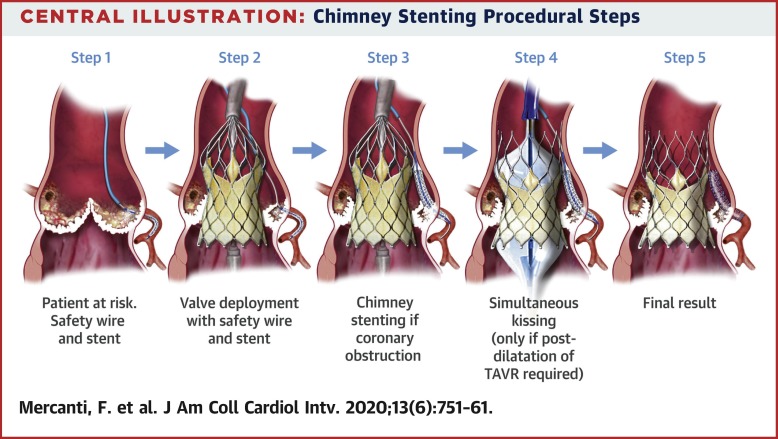JACC: Cardiovascular Interventions ( IF 11.7 ) Pub Date : 2020-03-16 , DOI: 10.1016/j.jcin.2020.01.227 Federico Mercanti 1 , Liesbeth Rosseel 1 , Antoinette Neylon 1 , Rodrigo Bagur 2 , Jan-Malte Sinning 3 , Georg Nickenig 3 , Eberhard Grube 3 , David Hildick-Smith 4 , Davide Tavano 5 , Alexander Wolf 6 , Giuseppe Colonna 7 , Azeem Latib 8 , Satoru Mitomo 8 , Anna Sonia Petronio 9 , Marco Angelillis 9 , Didier Tchétché 10 , Chiara De Biase 10 , Marianna Adamo 11 , Mohammed Nejjari 12 , Franck Digne 12 , Ulrich Schäfer 13 , Nicolas Amabile 14 , Guy Achkouty 14 , Raj R Makkar 15 , Sung-Han Yoon 15 , Ariel Finkelstein 16 , Danny Dvir 17 , Tara Jones 17 , Bernard Chevalier 18 , Thierry Lefevre 18 , Nicolo Piazza 19 , Darren Mylotte 20

|
Objectives
The aim of this study was to determine the safety and efficacy of chimney stenting, a bailout technique to treat coronary artery occlusion (CAO).
Background
CAO during transcatheter aortic valve replacement (TAVR) is a rare but often fatal complication.
Methods
In the international Chimney Registry, patient and procedural characteristics and data on outcomes are retrospectively collected from patients who underwent chimney stenting during TAVR.
Results
To date, 16 centers have contributed 60 cases among 12,800 TAVR procedures (0.5%). Chimney stenting was performed for 2 reasons: 1) due to the development of an established CAO (n = 25 [41.6%]); or 2) due to an impending CAO (n = 35 [58.3%]). The majority of cases (92.9%) had 1 or more classical risk factors for CAO. Upfront coronary protection was performed in 44 patients (73.3%). Procedural and in-hospital mortality occurred in 1 and 2 patients, respectively. Myocardial infarction (52.0% vs. 0.0%; p < 0.01), cardiogenic shock (52.0% vs. 2.9%; p < 0.01), and resuscitation (44.0% vs. 2.9%; p < 0.01) all occurred more frequently in patients with established CAO compared with those with impending CAO. The absence of upfront coronary protection was the sole independent risk factor for the combined endpoint of death, cardiogenic shock, or myocardial infarction. During a median follow-up time of 612 days (interquartile range: 405 to 842 days), 2 cases of stent failure were reported (1 in-stent restenosis, 1 possible late stent thrombosis) after 157 and 374 days.
Conclusions
Chimney stenting appears to be an acceptable bailout technique for CAO, with higher event rates among those with established CAO and among those without upfront coronary protection.
中文翻译:

TAVR期间烟囱支架用于冠状动脉闭塞:烟囱注册中心的见解。
目标
这项研究的目的是确定烟囱支架的安全性和有效性,烟囱支架是一种治疗冠状动脉阻塞(CAO)的救助技术。
背景
经导管主动脉瓣置换术(TAVR)期间的CAO是一种罕见的但通常是致命的并发症。
方法
在国际烟囱注册处,回顾性收集TAVR期间接受烟囱支架置入术的患者的患者和手术特征以及结果数据。
结果
迄今为止,在12800个TAVR程序中,有16个中心贡献了60个案例(0.5%)。进行烟囱式支架置入的原因有两个:1)由于已经建立了CAO(n = 25 [41.6%]);或2)由于即将发生的CAO(n = 35 [58.3%])。大多数病例(92.9%)具有1个或多个经典的CAO危险因素。前期冠状动脉保护术进行了44例患者(73.3%)。程序和院内死亡率分别发生在1例和2例患者中。心肌梗死(52.0%vs. 0.0%; p <0.01),心源性休克(52.0%vs. 2.9%; p <0.01)和复苏(44.0%vs. 2.9%; p <0.01)在患者中更频繁地发生与已建立CAO的公司相比,即将成立CAO的公司。没有预先的冠状动脉保护是导致死亡,心源性休克,或心肌梗塞。在612天的中位随访时间(四分位数范围:405至842天)中,报告了157和374天后发生2例支架衰竭的病例(1例支架内再狭窄,1例可能的晚期支架血栓形成)。
结论
烟囱式支架置入术似乎是CAO可以接受的救助技术,在那些已建立CAO的患者和未进行冠状动脉保护的患者中,发生率更高。






























 京公网安备 11010802027423号
京公网安备 11010802027423号